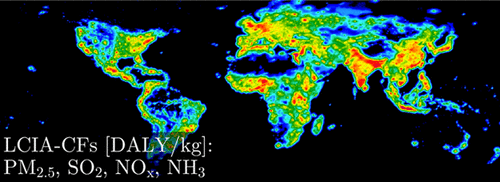当前位置:
X-MOL 学术
›
Environ. Sci. Technol.
›
论文详情
Our official English website, www.x-mol.net, welcomes your
feedback! (Note: you will need to create a separate account there.)
Globally Regionalized Monthly Life Cycle Impact Assessment of Particulate Matter
Environmental Science & Technology ( IF 10.8 ) Pub Date : 2020-11-23 , DOI: 10.1021/acs.est.0c05691 Christopher Oberschelp 1 , Stephan Pfister 1 , Stefanie Hellweg 1
Environmental Science & Technology ( IF 10.8 ) Pub Date : 2020-11-23 , DOI: 10.1021/acs.est.0c05691 Christopher Oberschelp 1 , Stephan Pfister 1 , Stefanie Hellweg 1
Affiliation

|
This work provides a globally regionalized approach for quantifying particulate matter (PM2.5) health impacts. Atmospheric transport and pollutant chemistry of primary particulate matter, sulfur dioxide (SO2), nitrogen oxide (NOx), and ammonia (NH3) from stack emissions were modeled and used to calculate monthly high-resolution maps of global characterization factors that can be used for life cycle impact assessment (LCIA) and risk assessment. These characterization factors are applied to a global data set of coal power emissions. The results show large regional and temporal differences in health impacts per kg of emission and per amount of coal power generation (5–1300 DALY TWh–1). While small emission reductions of PM2.5 and SO2 from coal power lead to similar health benefits across densely populated areas of Asia and Europe, we find that larger emission reductions result in up to three times higher health benefits in parts of Asia because of the nonlinear health responses to pollution exposure changes. Hence, many regions in Asia benefit disproportionately much from large coal power PM2.5 and SO2 emission reductions. NOx emission reductions can lead to equally high health benefits, where unfavorable atmospheric conditions coincide with elevated NH3 background pollution and large population (e.g., in Central Europe, Indonesia, or Japan but also numerous other places).
中文翻译:

全球范围内每月对颗粒物的生命周期影响评估
这项工作为量化颗粒物(PM 2.5)对健康的影响提供了一种全球区域化方法。对烟囱排放中的主要颗粒物,二氧化硫(SO 2),氮氧化物(NO x)和氨(NH 3)的大气迁移和污染物化学进行了建模,并用于计算全球表征因子的每月高分辨率图,这些图可以用于生命周期影响评估(LCIA)和风险评估。这些特征因素适用于全球煤炭动力排放数据集。结果表明,每千克排放量和每煤炭发电量对健康的影响在区域和时间上存在很大差异(5-1300 DALY TWh -1)。尽管燃煤发电中PM 2.5和SO 2的少量排放量在亚洲和欧洲人口稠密的地区带来了相似的健康益处,但我们发现,由于非线性因素,较大的排放量减少量可导致亚洲部分地区的健康益处提高三倍对污染暴露变化的健康反应。因此,亚洲许多地区从大型煤电PM 2.5和SO 2排放量减少中获得的收益不成比例。NO X排放量减少可导致同样高的健康益处,其中不利的大气条件与升高NH重合3 背景污染和人口众多(例如,在中欧,印度尼西亚或日本,以及其他许多地方)。
更新日期:2020-12-15
中文翻译:

全球范围内每月对颗粒物的生命周期影响评估
这项工作为量化颗粒物(PM 2.5)对健康的影响提供了一种全球区域化方法。对烟囱排放中的主要颗粒物,二氧化硫(SO 2),氮氧化物(NO x)和氨(NH 3)的大气迁移和污染物化学进行了建模,并用于计算全球表征因子的每月高分辨率图,这些图可以用于生命周期影响评估(LCIA)和风险评估。这些特征因素适用于全球煤炭动力排放数据集。结果表明,每千克排放量和每煤炭发电量对健康的影响在区域和时间上存在很大差异(5-1300 DALY TWh -1)。尽管燃煤发电中PM 2.5和SO 2的少量排放量在亚洲和欧洲人口稠密的地区带来了相似的健康益处,但我们发现,由于非线性因素,较大的排放量减少量可导致亚洲部分地区的健康益处提高三倍对污染暴露变化的健康反应。因此,亚洲许多地区从大型煤电PM 2.5和SO 2排放量减少中获得的收益不成比例。NO X排放量减少可导致同样高的健康益处,其中不利的大气条件与升高NH重合3 背景污染和人口众多(例如,在中欧,印度尼西亚或日本,以及其他许多地方)。











































 京公网安备 11010802027423号
京公网安备 11010802027423号